2023.08.01.78
Files > Volume 8 > Vol 8 No 1 2023
Effect of ethylene gas and Tryptophan amino acid in two oat varieties under soil stress conditions
Mohammed Radwan Mahmoud1, Haider Rezaq Leiby2 and Husam S M Khalaf3*
1 Department of Field Crops, Faculty of Agriculture, Muthanna University, Iraq. [email protected]
2 Department of Field Crops, Faculty of Agriculture, Muthanna University, Iraq. [email protected]
3 Department of Field Crops, Faculty of Agriculture, Muthanna University, Iraq. [email protected]
*Corresponding author. [email protected]
Available from: http://dx.doi.org/10.21931/RB/2023.08.01.78
ABSTRACT
A field experiment was conducted at the Research Station, Agriculture Faculty, Al-Muthanna University. The investigation was applied using the split-plot design, according to RCBD, with three replicates, varieties occupied the main plots, amino acid tryptophan occupied the sub-plots, and ethylene levels occupied the sub-sub-plot. The results showed that Shifaa Variety was distinguished in the harvest index. Results showed its distinction in the characteristic of the Panicle number. The interaction between the varieties and the amino acids showed increased grain yield percentage and the Panicle numbers when the amino acid was added. The exchange of cultivars with ethylene showed a decrease in plant height at 250 ppm and an increase in the Panicle numbers, the tiller numbers and the number of grains Panicle -1. As for the interaction of amino acid with ethylene, the treatment of adding acid and concentration of 250 ppm was superior with increasing some traits, including the number of grains Panicle -1, grain yield tons ha-1 and biological yield. While in the triple interaction, the treatment of (oat 11 × amino acid × the addition of Ethylene 250 ppm) was superior on some traits, including the increase in, the Panicle numbers and 1000 grain weight.
Keywords: ethylene gas, Tryptophan amino acid, oat, soil stress conditions
INTRODUCTION
Avena sativa L oat crop. It is one of the annual herbs of the Poaceae family, and oat rank seventh in terms of economic importance and production of grain crops; after wheat, rice, barley, corn, sorghum and millet, white oat is commonly known in cold and humid areas are grown1. Studies have shown that oatmeal benefits heart health because it helps reduce Peterson's cholesterol levels2; although the oat crop is globally essential, its productivity in Iraq is still very limited. EL-Bassiouny3 explained that spraying wheat plants with 25, 50 and 100 mg-1 liters of tryptophan after 30, 45 and 75 days of cultivation increases grain product and that the concentration of 50 mg-1 recorded the highest average weight of 1,000 grains at 42,899 G, the highest average grain product was 2033 kg /acre (4.840 miga g.h-1), while the highest average straw product was 8,609 miga g.h-1. tryptophan gave the highest number of hooks at 3.92and 5.56 plant-1 enables, and the highest average dry weight of 4.39 and 6.42 g, The average weight of the grain was highest at 2.85 and 5.18 g, and the highest average grain snob was 55.48 and 69.44 snabel-1 grains. In the EL-Bassiouny3 study, the average protein content was found to have increased by 18.52% as a result of paper spraying of tryptophan at a concentration of 50 mg-1 liters. Ethylene gas is a growth defect commonly used in grain crops, added to the plant in the form of spraying, and its effect depends on the spraying time and plant growth stage. Ethylene gas works by releasing ethylene into the plant by slow release mechanism4. Therefore, by affecting crop components and other properties, it reduces leg elongation and resistance to reflux, so this study aimed to know the optimal concentration of ethylene gas and Tryptophan amino acid in increasing the growth and production of the oat crop, Zarkani5 noted in his study of four varieties of oat (Shifaa, carlop, genzania, judo) found differences in the number of dalea, grain yield, bio-product, and harvest index between varieties, as the variety carlop outperformed better than the rest of the varieties in the first season, in giving it the highest average number of Panicles amounted to 940.70 Panicle m-2 and in a study conducted by the pilgrims6 in a field experiment on oat varieties in Tikrit, he found moral differences between the varieties in the category of the number of grains in dalal, and gave the item Hamel The highest average was 56.44Panicles.m-2, while the Icarda tall gave the lowest average of 34.92 Panicles.m-2 grains. In a field study conducted by Mut et al.7 in Turkey, on 25 genetic compositions of oat and found that there were moral differences in the characteristic of grain quotient between these genetic compositions; the field study conducted by Mut et al.7 included the cultivation of 25 genetic compositions of oat, the results showed that the designs differed in the proportion of protein in grains, where the genetic composition was recorded G23 was the highest average of 13.3%, while the average values of G2 and G25 were the lowest at 12.0 % for both in the protein ratio in cereals.
MATERIALS AND METHODS
Experience site
A field experiment was carried out at the Research Station of the College of Agriculture - University of Al-Muthanna, located on the Euphrates River (9 km northeast of the city of Samawa). During the 2021-2020 agricultural season, random soil samples were taken at a depth of 30 cm and then analyzed the physical and chemical qualities described in table(1).
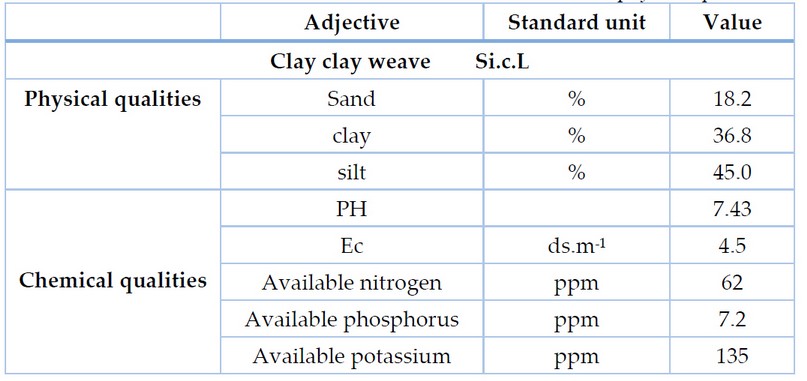
Table 1. Some chemical and physical qualities of field soil before agriculture.
Study factor
The experiment included the study of three factors, namely:
First: the first factor is two varieties of oat
1-V1 Shifaa Variety
2-V2 Oat 11
Second: Tryptophan (contains 7.56% organic nitrogen N, C organic carbon 22.8% and total amino acid 46.8%)
1-B0 without addition
2-B1 Add 15 ml per liter of water
Third: the third factor is the addition of ethylene gas :
1-E0 without addition
2-E1 add 250 ppm active substance h-1
3-E2 add 500 ppm active substance h-1
Design experience
The experiment was carried out using the order of the renegade panels - plots design Split - Split - According to the design of the entire randomized sectors (RCBD) and three bis, the main-plot panels and sub-plot were occupied by main-plot, while sub-sub-plot levels were occupied, and the convocation was distributed randomly within each sector, bringing the total units to Experimental (2×2×3×3=36 experimental units).
Field operations
Tillage, softening and leveling operations were carried out. The land was divided according to the design used into panels of an area of (2m× 2m = 4 m2) and the experimental units were separated by a distance (50 cm) to prevent interference between transactions. Agriculture was carried out on - 20202021 and at an seed rate of 120 kg H-1 (Mohammed, 2017) Tryptophan was added in the elongation and counterfeiting phases to the plant and even complete wetness. The addition of ethylene gas in the elongation phase sprayed the plant to complete wetness and urea fertilizer (N 46%) was used as a nitrogen source. It was added in equal impulses first after emergence and the, second at the branching stage and third at the elongation phase, and the fourth lining stage and in quantity (180 kg). N ha-1 (Hasani,2014), phosphate fertilizer was added in the form of superphosphate triphosphate (P2O5 46%), at a rate of 100kg H-1 (1995) at once before cultivation, and potassium fertilizer was added in the form of potassium sulfate (K (42% in the branching phase by60 kg ). K-1 (Taher,2005), irrigation and weeding were carried out whenever needed, and plants were harvested when they reached full maturity.
The following growth qualities have been studied:
• Number of Panicles m-2
• Number of grains in the Panicle m-1
• Weight of 1000 grains (g)
• Grain Product (Mega Gram. h-1)
• biological yield (Mega Gram h-1)
• Harvest index %
• Percentage of protein in cereals%
2.5. Statistical analysis: The data were statistically analysed using the Genstat statistical programme in a way that analysed all the variations and traits studied, and the calculation averages were compared using the lowest moral difference8 (LSD) at 0.05.
RESULTS
Number of Panicles m-2
Table 2 shows that oat 11, with the highest average number of Panicles m-2 recorded at 418.06 Panicles m-2, while the variety recorded the lowest average recovery of the number of Panicles m-2 and reached 390.7 Panicles m-2, may be due to the different genetic structure to which the ability to form fertile traits is associated. The same table shows that there is effect of amino acid in increasing the number of Panicles m-2 where the treatment of the addition of amino acid recorded the highest average of 429.57 Panicles m-2, while the control treatment (not adding amino acid) recorded the lowest average of 378,81 Panicles m-2, the reason for this is the increase in the number of Panicles m-2. Table (2) shows the effect of ethylene spraying in the number of Panicles m-2 and recorded the highest average concentration at 250 ppm, at 413.77 Panicles m-2, recorded the lowest average concentration at 500 ppm, which reached 396.1 Panicles m-2, this is in line with Hashim14 and Al-Dahari15, who explained that the addition of ethylene gas leads to an increase in the number of Panicles m-2 in the wheat, barley and oat yield. As we note from table (2) that the combination (varieties×amine acid) increased the number of Panicles m-2 and morally difference when spraying the amino acid of the oat 11 and this characteristic recorded the highest average number of Panicles m-2 of treatment oat 11 × amino acid addition and reached 458.38 Panicles m-2, The lowest average treatment of oat was 11×in addition of amino acid, which amounted to 376.09 Panicles m-2 and was not morally different from the Shifaa combination of × no acid addition, which amounted to 382. Panicles m-2. As we note from table (2) that the combination (the ethylene gas × ethylene gas spraying) recorded the highest average when treated as oat 11 × adding ethylene gas at a concentration of 250 ppm at 438.11 Panicles m-2 While the treatment recorded Shifaa ×the addition of ethylene gas is the lowest average at 380.11 Panicles m-2, which may be due to the genetic difference between varieties or the difference in varieties by the extent to which they respond to the spraying× of ethylene gas) The overlap between them was moral and recorded the highest average when treating the addition of amino acid ×the addition of ethylene gas at the concentration of 250 ppm, where it was 479,82 Panicles m-2, While the transaction recorded the non-addition of amino acid× the addition of ethylene gas at the concentration of 250 ppm the lowest average at 348.32 Panicles m-2. As Table 2 shows, the triple interaction of the study factors was significant of oat 11 ×in addition of amino acid ×the addition of ethylene gas recorded at the concentration of 250 ppm the highest average number of Panicles m-2 reached 525.44 Panicles m-2 and recorded a Shifaa treatment ×in addition of amino acid ×the addition of ethylene gas at the concentration of 250 ppm the lowest average number of Panicles m-2 and reached 350.77 Panicles m-2.
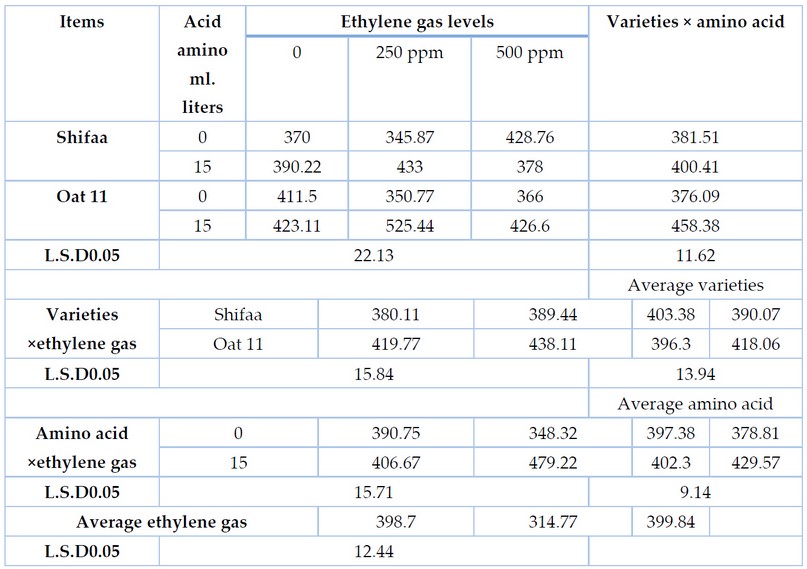
Table 2. The effect of varieties, amino acid and ethylene gas and the overlap between them in the number of Panicles.m-2.
Number of grains. Panicles.m-2
The results of table 3 showed the variety oat 11 where the highest average number of grains was recorded. Those who pointed out that the difference in varieties in this characteristic is due to the fact that the character of the number of grains in Panicle is a quantitative trait positively associated with genetic and environmental factors. In table 3 we note that the number of grains in Panicle increased as a result of the spraying of amino acid, where the treatment of adding acid (adding amino acid) recorded the highest average number of grains in Panicle and reached 24.43 grains.Panicles.m-2, while the control spray treatment recorded the lowest average at 22. 63 grains. Panicles.m-2 may be due to the role of amino acid, which has increased the rate of fertility and reduced the rate of egg abortion in addition to the role of amino acid in increasing the amount of carbohydrates transferred from manufacturing areas to effective growth sites.
In table 3 we note the effect of ethylene gas on the number of grains in Panicle, where the proportion of grains in Panicle increased with the addition of ethylene gas, where the highest average concentration was recorded at 250 ppm and reached 26 grains.
In table 3 we note that bilateral interference (varieties ×ethylene gas) was moral, with oatmeal treatment recorded 11 × addition ethylene gas at a concentration of 250 ppm, the highest average number of grains in Panicle at 29.78 grains. Panicles.m-2, while the lowest average Shifaa treatment was recorded ×addestion ethylene gas at a concentration of 500 ppm. It reached 19.00 grains.
In table 3 we note that the bilateral interference (amino acid × ethylene gas) where the transaction recorded the addition of amino acid × the addition of ethylene gas at the concentration of 250 ppm, the highest average of 28.38 grains. Panicles.m-2, while the transaction recorded the addition of amino acid ×the addition of ethylene gas at the concentration of 500 ppm the lowest average 20.23 grains.Panicles.m-2.
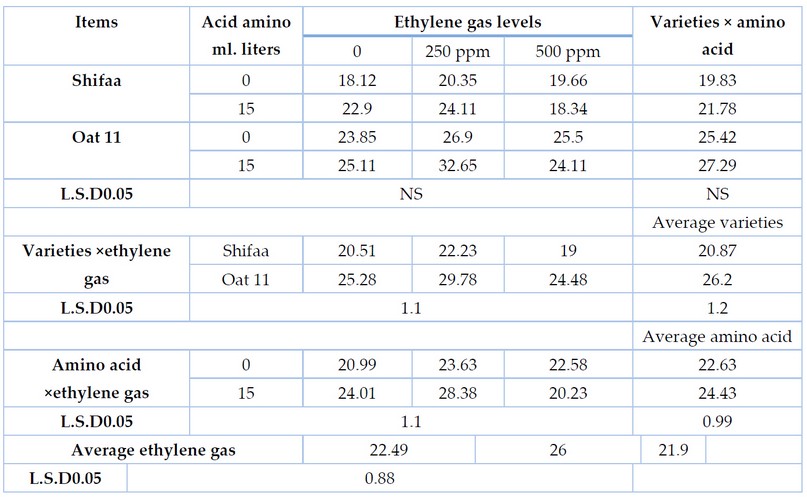
Table 3. The effect of varieties, amino acid and ethylene gas and the overlap between them in the number of grains Panicles.m-2.
The weight of 1000 grains
Table 4 of the results show a decrease in the weight of 1000 grains with the addition of ethylene gas, where the highest average was recorded when the control was treated 45.00 g, while the lowest average was recorded at 250 ppm where it reached 43. 99 g, this may be due to an increase in the number of ethylene gas sprays, which has increased the competition for photosynthesis products and thus reduced the amount of manufactured materials that reach the grain during the full period. We note in table 4 that the interference of (varieties ×ethylene gas) as a result of spraying withethylene gas was recorded at the highest average when Shifaa × not adding ethylene gas at 45.06 g and was not morally different from the treatment of oat 11× the addition of ethylene gas when concentrating 250 ppm, 46 g, while the treatment recorded Shifaa × the addition of ethylene gas at the concentration of 250 ppm the lowest average at 42 g, which may be due to the genetic difference between varieties or different varieties by the extent to which they respond to a spray withathylene gas.
As we note from table 4, the interference (acid × ethylene gas) was the Significant statistical differences and recorded the highest average when treating the addition of amino acid ×the addition of ethylene gas (compared) to 45.95 g, it did not differ Significant from the treatment of not adding amino acid × the addition of ethylene gas at a concentration of 500 ppm, 46.5 g, while the transaction recorded the addition of amino acid × adding ethylene gas at a concentration of 500 ppm lowest average at 43.06 g. As we note from table 4, the triangular overlap of the study factors was moral, with the treatment of oat recorded 11 × the addition of amino acid × the addition of ethylene gas at the concentration of 250 ppm the highest average of 49 g and was not Significant different from the treatment of oat 11 × the addition of amino acid × add athylene gas and the treatment of oat 11 × addition of amino acid × adding ethylene gas at a concentration of 500 ppm was recorded the lowest average was 41.04 g.
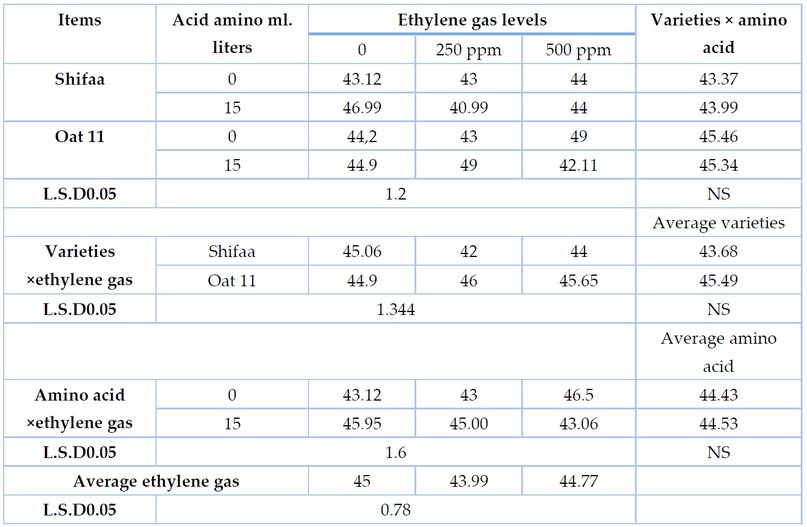
Table 4. The effect of varieties, amino acid and ethylene gas and the overlap between them in the weight of 1000 grains
Yield miga g.h-1
Table 5 shows the Significant statistical differences when spraying ethylene gas where the highest average was recorded at a concentration of 250 ppm and reached 5.24 miga g.h-1, while the control transaction recorded the lowest average of 4.17 miga g.h-1, due to an increase in the number of Panicles and the number of grains. We note in table 5 that interference (varieties of ×amine acid) increased the grain product when spraying amino acid for a Shifaa variety, while oat 11 decreased the grain product when spraying amino acid. This status recorded the highest average grain for treatment Shifaa ×in addition of amino acid was 5.42 miga g.h-1, while the lowest average treatment for oat 11 × in addition of amino acid, which was 4.15 mg.h-1. As table 5 shows, the interference (amino acid× ethylene gas) where the treatment recorded the addition of amino acid ×the addition of ethylene gas at the concentration of 250 ppm the highest average of 5.86 miga g.h-1, while the addition of amino acid was recorded × the addition of athylene gas the lowest average of 3.97 miga g.h-1.
As we note from table 5, the tripartite interaction of the study factors was significant, with the treatment recorded Shifaa × in addition of amino acid × the addition of ethylene gas at a concentration of 250 ppm higher. The average grain product was 6.55 miga g.h-1, while the lowest average oatmeal treatment was 11 × in addition of amino acid × the addition of ethylene gas was 3.07 mega g.h-1 .
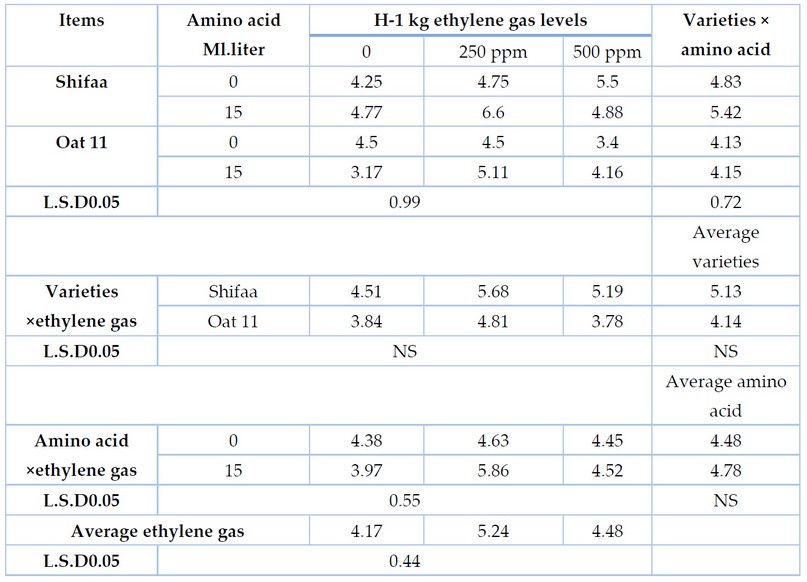
Table 5. The effect of varieties, amino acid and ethylene gas and the overlap between them in the characteristic of the grain quotient megagram.ha-1.
The biological yield (mega g.h-1)
Table 6 shows the Significant statistical differences in biological yield when using ethylene gas and recorded the highest average at a concentration of 250 ppm gave 11.90 mega g.h-1 , while the control transaction recorded the lowest average of 10.47 mega g.h-1, which is consistent with Hashim,2006, where the addition of athylene gas positively affected the increase in The biological yield.
We note in table 6 that interference (ethylene gas × varieties) shows the Significant statistical differences in biological yield ethylene gas x Shifaa treatment added ethylene gas at concentration of 250 ppm at 12.57mega g.h-1, while Shifaa treatment ×no addition Ethylene gas was recorded the lowest average at 9.69 mega g.h-1.
Table 6 also shows that the interference (amino acid × ethylene gas) where the treatment recorded the addition of amino acid ×the addition of ethylene gas at the concentration of 250 ppm the highest average of 12. 96 mega g.h-1, while the transaction recorded no addition of amino acid ×the addition of ethylene gas recorded the lowest average of 10.65mega g.h-1.
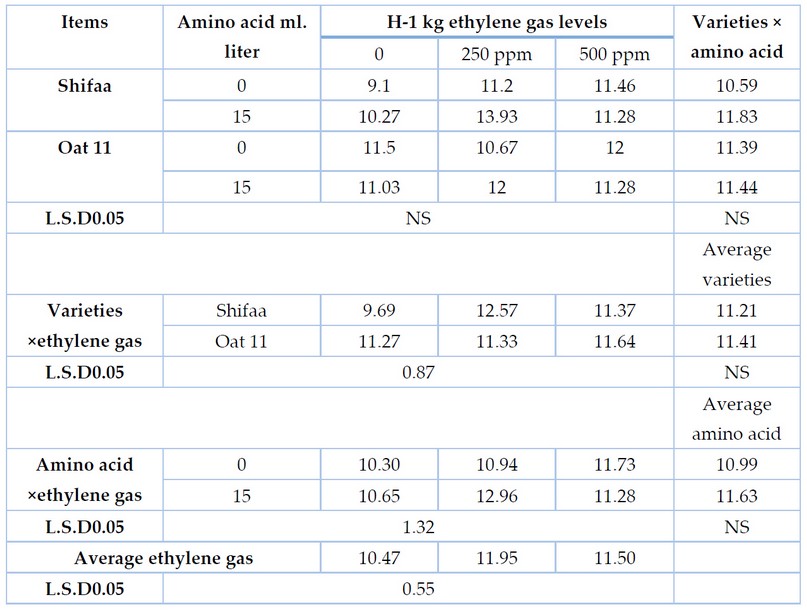
Table 6. The effect of varieties, amino acid and ethylene gas and the overlap between them in the mega g.h-1
Harvest index%
The varieties showed Significant statistical differences between them in the harvest index, where the variety Shifaa recorded the highest average of the harvest index and reached 45.07%, while the oat 11 recorded the lowest average for this characteristic at 35.71%, and may be due to the difference in genetic composition that controls the ability to convert photosynthesis products into an economic product. We note in table 7 that interference (varieties ×ethylene gas) . Shifaa × not adding ethylene gas gave 47.60%, while oat 11 treatment × no addition of ethylene gas recorded the lowest as. %32.91.
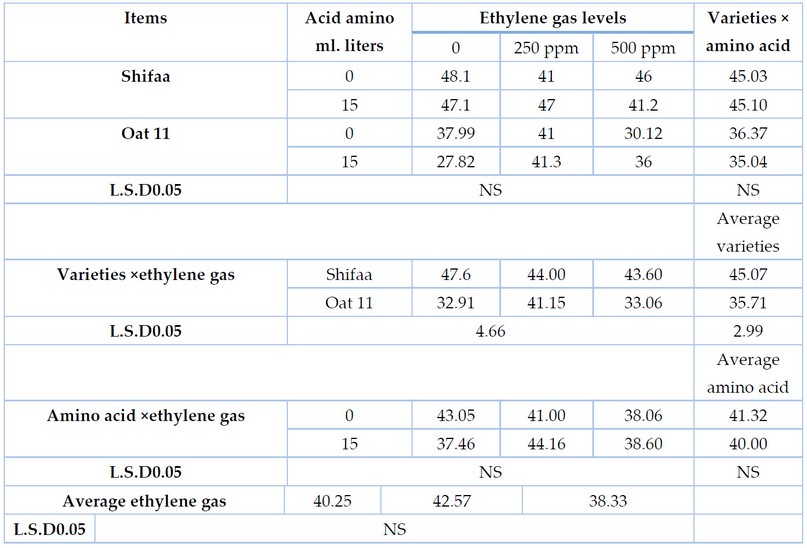
Table 7. The effect of varieties, amino acid and ethylene gas and the overlap between them in harvest index %
Protein in cereals%
Table 8 shows when spraying amino acid where the treatment of amino acid spray recorded the highest average grain protein synth of 18.23% and a moral difference from the control treatment where recorded the lowest average of 14.24%, and may be due to the fact that the free amino acid when added is a source of essential nitrogen in the construction and formation of protein and enzymes and energy processing for vital processes. Table (8) shows when spraying ethylene gas where the highest average grain protein was recorded at a concentration of 500 ppm 18.60%, and there was no Significant statistical differences from the treatment of 250 ppm to 16. 51% protein in cereals, while the control treatment (no ethylene gas addition) recorded the lowest average of 14.53%.
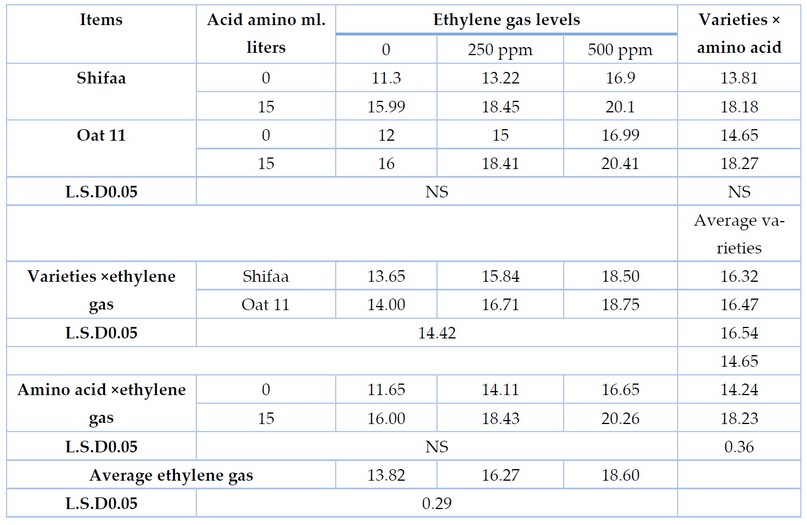
Table 8. The effect of varieties, amino acid and ethylene gas and the overlap between them in grain protein.
DISCUSSION
The results were consistent with the findings of 9' 10 in the difference in oat varieties in the number of Panicles m-2. The availability of conditions helped to increase the number of Panicles m-2 when adding amino acid, which is consistent with 11 '12 '13, who pointed to the effect of amino acid in increasing the number of Panicles m-2 for wheat crops. In Table 3 we note the effect of ethylene gas on the number of grains in Panicle, this is consistent with 16' 14 of the moral effect of different ethylene gas compositions in the number of grains in spike for wheat. 16, 17, 14 '15, they explained that there is an increase in grain yield for barley, wheat and oat crop when the concentration of medium ethylene gas but the grain product decreases at high concentration. Moreover, 15 pointed out that the harvest index values in the oat crop differed by varieties and genetic composition. Finally when spraying amino acid, the treatment of amino acid spray recorded the highest average grain protein synth, this is may be due to the fact that free amino acid when added is a source of essential nitrogen in the construction and formation of protein and enzymes and energy processing for vital processes 18,19.
CONCLUSIONS
The interaction of cultivars with ethylene showed a decrease in plant height at 250 ppm and increase the Panicle numbers, the tiller numbers and the number of grains Panicle -1. As for the interaction of amino acid with Eth-ylene, the treatment of adding acid and concentration of 250 ppmwas superior with increasing some traits, in-cluding the number of grains Panicle -1, grain yield tons ha-1 and biological yield. While in the triple interaction, the treatment of (oat 11 × amino acid × the addition of Ethylene 250 ppm) were superior on some traits, including the increase in, the Panicle numbers and 1000 grain weight.
REFERENCES
1. Soratto , R.P. ; C. A.C. Crusciol; G.S. A. Castro ; C. H.M. D. Costa and J. F. Neto. Leaf application of silicic acid to white oat and wheat .R. Bras. Sci . Solo, 2012. 36:14538-1644.
2. Taher, F.M. The effect of paper feeding with iron, zinc and potassium in the growth and product of triticum aestivum wheat . L Doctoral Thesis. Faculty of Agriculture - University of Baghdad. 2004.
3. EL-Bassiouny, H.M.S. physiological responses of wheat to salinity alleviation by nicotinamide and tryptophan. Int. J. Agric. Biol., 2005. 7(4): 653-659 .
4. Abdalbakee, H. N. & Mohammed, Th. T. Effect of using different levels of azolla as a substitute for soybean meal in the production performance of fish carp. Plant Archives. 2019, 19(1): 573-577. Doi: 10.13140/RG.2.2.23568.15367.
5. Zarkani, M.S.M. The effect of soaking seeds with peridoxin and boron sprays in the grain product and its ingredients for four varieties of Avena sativa oat. L Doctoral Thesis, Faculty of Agriculture, University of Baghdad. 2017.
6. Al Hajog, Y.A.M. The effect of some environmental factors in genetic compositions of oat in the conditions of Salaheddine province. Ph.D. Thesis - Faculty of Agriculture - Tikrit University. 2019.
7. Mut, Z, H. Akay and Ö. D. E. Köse. Grain yield, quality traits and grain yield stability of local oat cultivars. Journal of Soil Science and Plant Nutrition, 2018. 18 (1): 269-281.
8. Al-Rawi, K.M. and Khalafallah, A. Design and analysis of agricultural experiments. 1980.
9. Al-Hajjuj, Y.A. and A.H.A. Anis. The role of the number of irrigations in the performance of several genetic models of avena sativa oat . L for its quantitative qualities. 1st International And Scientific Conference, Faculty of Science, Tikrit University (December 17-18, 2018).
10. Abdulateef, S.M. ,O.K. Atalla, MQ. Al-Ani, TH. T. Mohammed, F.M. Abdulateef, O.M. Abdualmajeed , K. Mahmod. The effect of the electric shock on embryonic development and neurophysiological traits in the chick's embryo . IOP Conference Series: Earth and Environmental Science.2021, 761(1), 012090.
11. Baqir, H.A. Physiological behavior of three varieties of wheat bread under the influence of amino acid and yeast powder. Doctoral thesis .University of Baghdad. Faculty of Agricultural Engineering Sciences. Field Crops Department. 2018.
12. Mohammedi, M.H.M. The effect of the spraying date with nutr-green amino acid compound concentrations on the qualities of growth and product and its components and quality recipes for varieties of chlamyli wheat tritikal master's thesis - University of Tikrit - Faculty of Agriculture - Department of Field Crops. 2018.
13. Abdul Karim, S.J.A. The effect of paper spraying with amino acid and copper in the product and quality of varieties of soft wheat Tritivuma estivum. L. Master's Thesis. 2020.
14. Hashim, R.T.J. The effect of planting dates on the growth and product of different genetic compositions of the Avena sativa oat crop. L Master's Thesis, Faculty of Agriculture, Muthanna University. 2014.
15. Al-Dahir, A.M.S. The effect of the paper feeding of athyphon and boron in the growth and pollen of oat (Avena sativa). L) . Doctoral Thesis, Faculty of Agriculture, Anbar University. 2020.
16. Al-Obaidi, M.S. Use of clatar and athyphon to improve growth, outcome and dry endurance of two varieties of wheat (Triticum aestivum ). L) Doctoral Thesis, Department of Field Crops, Faculty of Agriculture, University of Mosul. 2001.
17. Abdul Mughni, A.M.T. The effect of celtar and athion in the growth and product of some varieties of wheat (Triticum aestivum ). L) Doctoral thesis, Department of Field Crops, Faculty of Agriculture, University of Baghdad. 2001.
18. Khudair, M.Y Alyassein, R.N, Jasim, F.M. Improving the Quality of Ground Water in Some Areas of Al-Anbar Governorate by Recharging with Rainwater. IOP Conference Series: Earth and Environmental Science.2021, 761(1), 012009
19. Al Salman, N.T.Sh. and J.K.M. Al-Gharawi. Effect of Eucalyptus leaves water extract on some productive traits of broilers. Plant Archives Vol. 19, Supplement 1, 2019 pp. 920-923.
Received: January 15, 2023 / Accepted: February 25, 2023 / Published:15 March 2023
Citation: Mahmoud M R, Leiby H R and Khalaf H S M. Effect of ethylene gas and Tryptophan amino acid in two oat varieties under soil stress conditions. Revis Bionatura 2023;8 (1) 78. http://dx.doi.org/10.21931/RB/2023.08.01.78
